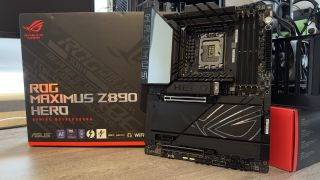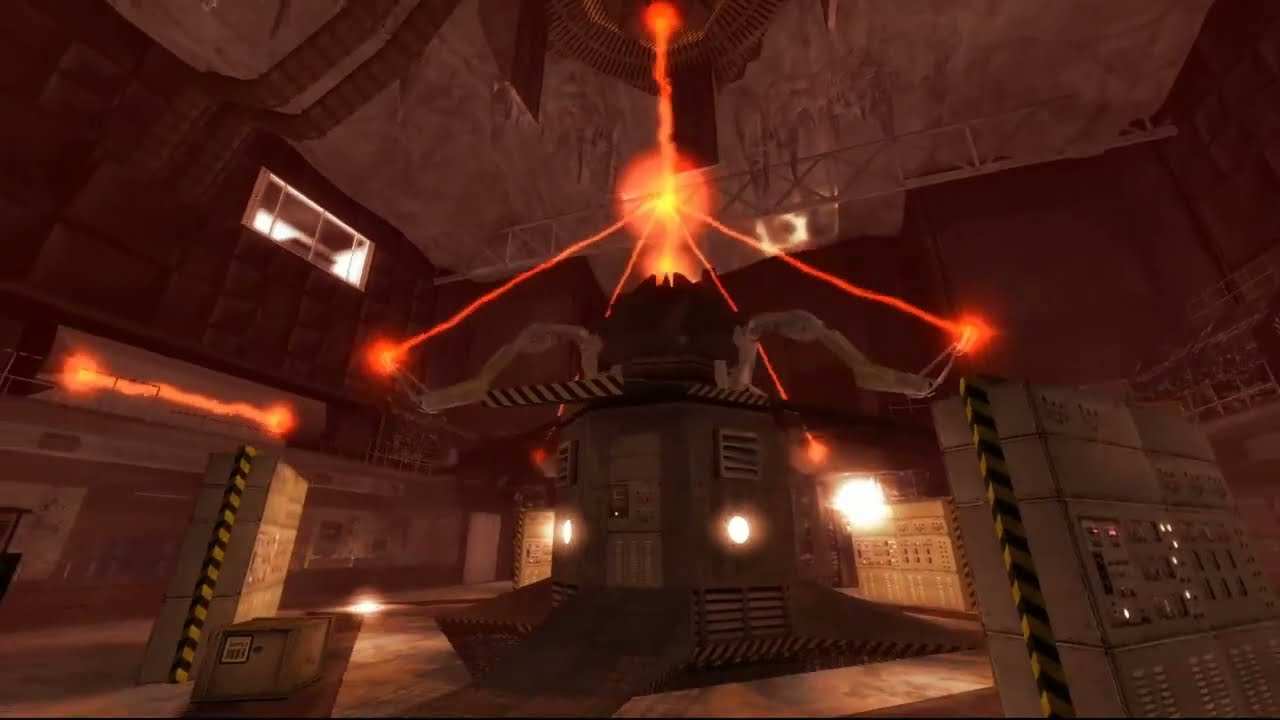
Intel’s new Core Ultra 200S series of desktop processors launched to a mostly negative response, due to the regression in gaming performance compared to the previous generation of chips. However, they are pretty good at content creation tasks and they consume far less power in gaming, so they could be suitable for some folks. But what motherboard do you buy?
The new Arrow Lake CPUs only fit into an LGA1851 socket, so you can’t fit one in a previous-generation motherboard. At the moment, there’s only one chipset available (Z890) and most board vendors have focused on creating ATX-sized models that are quite expensive. Then again, if one is going to spend over $500 on a Core Ultra 9 285K, you’re probably best off getting a suitably capable motherboard to ensure the setup lasts you as long as possible.
The ROG Maximus Z890 Hero isn’t at the very top of Asus’ Intel motherboard range but it’s not far off, as it sports as comprehensive a set of features as one could possibly ask for. Naturally, that means the price tag is equally as big, but that’s par course for high-end motherboards these days.
Pretty much everything about the ROG Maximus Z890 Hero is big—opening the enormous packaging reveals a motherboard that weighs in at an astonishing 3.6 kg (8 lbs). From the huge primary M.2 slot heatsink to the massive polychromic display, nothing about it is subtle even though it doesn’t sport in-your-face graphics.
Asus ROG Maximus Z890 Hero specs
Socket: Intel LGA1851
Chipset: Intel Z890
CPU compatibility: Intel Core Ultra 200S desktop
Form factor: ATX
Memory support: DDR5-4800 to DDR5-9200+(OC), up to 192 GB, CUDIMM supported
Storage: 6x M.2, 4x SATA, 1x SlimSAS
USB (rear): 2x Thunderbolt 4 Type-C 40 Gbps, 1x USB 3.1 Type-C 10 Gbps, 4x USB 3.1 Type-A 10 Gbps, 4x USB 3.0 Type-A 5 Gbps
Display: 1x HDMI 2.1, 2x USB/Thunderbolt 4
Networking: Intel 2.5G LAN, Realtek 5G LAN, Wi-Fi 7
Audio: Realtek ALC4082
Price: $692 | £713 | AU$1,249
Just read through the specifications to see what I mean. Few motherboards come with six M.2 slots and fewer still have two Gen 5 slots and four Gen 4 ones. If that’s not enough storage for you, then there are a further four SATA ports and a SlimSAS connection, for additional NVMe or SATA drives. How about 11 USB ports on the rear IO panel and a further 10 via headers?
If overclocking is more your thing, then you’re not going to be disappointed. Power is handled by a total of 27 stages (22 of which are rated to 110 amps), covered by some of the chunkiest heatsinks I’ve seen for a very long time. I’m a little surprised that Asus didn’t choose to use active cooling for the VRMs but given Arrow Lake’s reduced power consumption compared to Raptor Lake, it’s perhaps not necessary.
The engineers at Asus have worked hard at making the motherboard more user-friendly (‘EZ DIY’, as Asus calls it) and it’s replete with lots of so-called ‘Q’ features—M.2 Q-Release, M.2 Q-Slide, M.2 Q-Latch, PCIe Slot Q-Release Slim, Q-Antennae, and so on. Fortunately, it’s not just marketing nonsense, as the features genuinely make it really easy and simple to install and remove graphics cards, SSDs, and the Wi-Fi aerial.
I do wish Asus would refresh its BIOS layout and structure, though. It’s packed full of options as always and now defaults to a 1080p resolution (so it looks crisp and clear) but it’s somewhat overwhelming at times. The jump in complexity between Easy and Advanced modes can’t be very welcoming for beginners, that’s for sure. Still, at least the Q-Dashboard is a nice touch, displaying an overview of your motherboard’s parts and connectors.
Performance testing motherboards is a somewhat tricky affair, mostly because there’s usually very little difference between various models in most tests. It’s only when one uses highly specific synthetic benchmarks that small differences begin to make an appearance, and these rarely translate into a noticeable discrepancy in real-world situations.
This is especially true in the case of Z890 motherboards because they’re all brand new in the market, so there isn’t a wealth of results to compare against. Hence why there are only two other boards in the results below: an MSI MEG Z890 Ace and an MSI MAG Z890 Tomahawk.
PC Gamer test rig
CPU: Intel Core Ultra 9 285K
Cooler: Asus ROG Ryujin III 360 ARGB Extreme
RAM: 32 GB Lexar Thor OC DDR5-6000
Storage: 2 TB Corsair MP700
PSU: MSI MAG AB50GL 850 W
OS: Windows 11 23H2
Chassis: Open platform w/ 2x 140 mm fans
Monitor: Acer XB280HK
For the most part, you can see there’s little to separate them, especially in gaming. However, the Factorio test really stands out, as the Asus ROG Maximus Z890 Hero achieves a 21% faster result than either of the MSI boards. I’ve spent some time discussing this with both companies without much success in understanding the result.
The only thing I can think that might be behind it is that the Asus motherboard applies a fixed clock speed for the Core Ultra 9 285K’s internal ring bus, whereas the MSI boards allow it to vary. Intel tells me that Asus’ approach is the correct one.
However, the ROG Maximus Z890 Hero is slower in the 7zip tests and not by a margin of error, achieving a 14% lower result in the decompression benchmark. Games store all data in a compressed format and decompress it on the fly when required so the 7zip figure suggests that one might notice a decrease in gaming performance when using the Asus motherboard. But as you can see in the gaming results, it doesn’t affect those particular games.
Tracking the CPU package power, VRM and chipset temperatures during the main benchmarks will highlight any deficiencies in a motherboard’s power delivery and cooling systems and while there are some disparities between the three motherboards, they’re not significant. The ROG Maximus Z890 Hero’s heatsinks do an excellent job of keeping everything cool but given that the MSI board’s do likewise, I do wonder if their vast size was really necessary.
But I have no such concerns over the heatsink for the primary M.2 slot. It’s a monstrous slab of metal and as you can see, it does a superb job of keeping a PCIe 5.0 SSD’s temperature under control.
Buy if…
✅ You want as many features as possible: This motherboard has all the ports, slots, and sockets you’re ever likely to need.
Don’t buy if…
❌ You’re on a tight budget: Handing over nearly $700 for a motherboard, even one as good as this, means it’s not one for a sensibly priced gaming PC build.
At no point did it ever exceed 70 °C and this is the only motherboard I ever tested that’s managed to do this with a Gen5 SSD. The fact that it’s so easy to remove and reattach is the proverbial cherry on top.
There’s an awful lot to like about the Asus ROG Maximus Z890 Hero. Despite its sheer mass, hulking heatsinks, and pretty polychromic display, it’s a relatively understated design that should suit most PC enthusiasts.
Underneath all the metal is a motherboard that’s loaded to the hilt with ports, slots, and sockets. If you want to build a new gaming PC with an Intel Core Ultra 200S processor, you’re not going to be left wishing for anything.
Well, apart from its price, that is. At a few bucks over $690, it is very expensive—and while there are even pricier Z890 motherboards on the market, that price tag is enough to make anyone look twice before buying.
The Asus ROG Maximus Z890 Hero is an excellent motherboard, of that there’s no doubt, and should easily last you through many years of use. Whether that’s enough to justify spending that kind of money, especially when more LGA1851 motherboards will come out in 2025, is far less certain.



